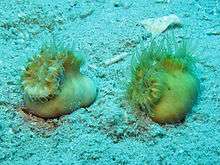Heteropsammia
Heteropsammia is a genus of apozooxanthellate corals that belong to the family Dendrophylliidae.[2]
| Heteropsammia | |
|---|---|
 | |
| Heteropsammia cochlea | |
| Scientific classification | |
| Kingdom: | Animalia |
| Phylum: | Cnidaria |
| Class: | Anthozoa |
| Order: | Scleractinia |
| Family: | Dendrophylliidae |
| Genus: | Heteropsammia Edwards & Haime, 1848[1] |
Anatomy
These corals consist of free-living, single polyps, of a diameter of around 2.5 cm.[2] They form a symbiotic relationship with a sipunculid worm, Aspidosiphon corallicola.[3] The worm lives in a cavity situated on the under surface of the coral and it pulls the polip over sandy substrates. They also present a facultative symbiotic relationship with zooxanthellae of the Symbiodinium genus, as this link has been observed at shallow waters (under 40 m), but not at greater depths (where the corals live without the algae).[4] Heteropsammia corals can sometimes stablish symbiotic relationships with other marine species, such as hermit crabs,[5] that live in the cavity where the endosymbiotic Sipunculid worm is usually located.[6]
Nutrition
Heteropsammia corals (of the species Heteropsammia cochlea) have been observed ingesting salps in Leuk Bay, Koh Tao, Gulf of Thailand, thanks to their large gape, as the salps were larger than the corals mouth opening.[7]
Species
The following species are listed in the World Register of Marine Species (WoRMS):[1]
- Heteropsammia cochlea Spengler, 1781
- Heteropsammia eupsammides Gray, 1849
- Heteropsammia moretonensis Wells, 1964
Notes and references
- "Heteropsammia Milne Edwards & Haime, 1848". WoRMS. World Register of Marine Species. Retrieved 2019-09-24.
- Hoeksema, B. W.; Matthews, J. L. (2015-06-15). "Partial bleaching in an assemblage of small apozooxanthellate corals of the genera Heteropsammia and Heterocyathus". Coral Reefs. 34 (4): 1227. Bibcode:2015CorRe..34.1227H. doi:10.1007/s00338-015-1314-y. ISSN 0722-4028.
- Hoeksema, B.W.; Best, M.B. (1991). "New observations on scleractinian corals from Indonesia: 2. Sipunculan-associated species belonging to the genera Heterocyathus and Heteropsammia". Zoologische Mededelingen. 65 (16): 221–245. OCLC 945429864.
- Goreau, T. F.; Yonge, C. M. (February 1, 1968). "Coral Community on Muddy Sand". Nature. 217 (5127): 421–423. Bibcode:1968Natur.217..421G. doi:10.1038/217421a0. ISSN 0028-0836.
- See, for instance, Diogenes heteropsammicola.
- Fujii, Takuma (2016-05-17). "A hermit crab living in association with a mobile scleractinian coral, Heteropsammia cochlea". Marine Biodiversity. 47 (3): 779–780. doi:10.1007/s12526-016-0505-2. ISSN 1867-1616.
- Mehrotra, R.; Scott, C. M.; Hoeksema, B. W. (2015-08-19). "A large gape facilitates predation on salps by Heteropsammia corals". Marine Biodiversity. 46 (2): 323–324. doi:10.1007/s12526-015-0379-8. ISSN 1867-1616.